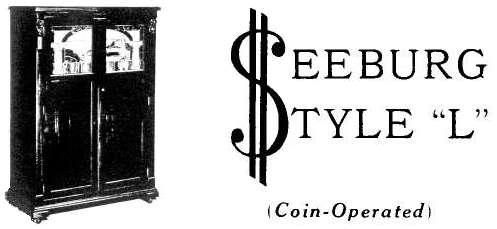| You Are Not Logged In | Login/Get New Account |
|
Please Log In. Accounts are free!
Logged In users are granted additional features including a more current version of the Archives and a simplified process for submitting articles. |
|
MMD
 Gallery
Gallery
 Tech
Tech
 seeburgL.htm
seeburgL.htm
|
|
And Other A-roll Cabinet Pianos by Art Reblitz
The small Seeburg L cabinet piano has 54 notes The lowest bass note is the third B below middle C, equal to note 15 in an 88-note piano. The highest treble note is the third E above middle C, equal to note 68 in an 88-note piano. The pitch standard is A=435 Hz. With eleven wrapped two-string bass unisons playing from low B up to A, the lowest plain string on the long bridge is the second A# below middle C (note 26 in an 88-note piano). The Seeburg L plays 65-hole style "A" rolls These rolls play 58 notes, from C through A (notes 16 through 73 in an 88-note piano). Although the lowest note in an "A" roll is C and the lowest note in a Seeburg L is B, the L does not transpose, but is tubed to play at concert pitch. Here's how:
"A" roll scale for cabinet style Seeburg L coin piano
1 Low vacuum to piano stack
2 Sustaining pedal
3 Play (cancel rewind)
4 C (lowest note in roll; second lowest note in piano)
5 C#
6 D
7 D#
8 E
9 F
10 F#
11 G
12 G#
13 A
14 A#
15 B (1st and 13th notes in piano, coupled together with
a "jumper" tube on stack)
chromatically up through
56 E (highest playing note in piano)
57 F (teed to next lower F, tracker bar hole 45)
58 F# (teed to next lower F#, tracker bar hole 46)
59 G (teed to next lower G, tracker bar hole 47)
60 G# (teed to next lower G#, tracker bar hole 48)
61 A (teed to next lower A, tracker bar hole 49)
62 Not used (for pipes or xylophone in larger models)
63 Rewind
64 Mandolin attachment; hammer rail up (soft)
65 Shutoff (subtracts one credit from coin accumulator)
The same piano and scale are used in the late style keyboardless Seeburg model C with xylophone, the Western Electric Mascot, and the Coinola Cupid. Western Electrics and Coinolas do not have a pneumatic expression device for tracker bar hole #1, and use only the hammer rail for automatic expression. Larger keyboardless A-roll pianos, including the Seeburg K and Western Electric X, were copied from the Automatic Musical Co. keyboardless piano made by Haddorff and later used in the Link 2-E cabinet piano. This piano has 61 notes tuned from G-G In A-roll pianos, the lowest three notes are not used, leaving a 58-note scale of low A# through high G and transposing "A" rolls down two half steps Consequently they sound a little "tubby" compared to their keyboard-style counterparts. (The same piano back was also used in G-roll and 4X-roll pianos including the Seeburg KT, KT Special, equivalent Western Electric models, and the Nelson Wiggen 4X, 5X, and 6 With three unused bass notes and 10 octave-coupled bass notes, they play in the correct key, unlike their A-roll counterparts.) A few Nelson-Wiggen Style 8 keyboardless pianos that play "A" rolls have little 54-note pianos as in the Seeburg L et al, but most of them have full 58-note pianos They are non-transposing, making them many collectors' favorite little A-roll pianos because they are the only ones that play the music as intended They are also the only little American nickelodeons that were originally tuned to A-440. Art Reblitz
Many tracker scales and key frame layouts are included in "The Golden Age of Automatic Musical Instruments," copyright 2001 by Arthur A. Reblitz, and in "Treasures of Mechanical Music," copyright 1981 by Arthur A. Reblitz and Q. David Bowers.
18 March 2002 |
|
|
|
|
|
|
|
|
|
CONTACT FORM: Click HERE to write to the editor, or to post a message about Mechanical Musical Instruments to the MMD Unless otherwise noted, all opinions are those of the individual authors and may not represent those of the editors. Compilation copyright 1995-2026 by Jody Kravitz. Please read our Republication Policy before copying information from or creating links to this web site. Click HERE to contact the webmaster regarding problems with the website. |
|
|
||||||
|

